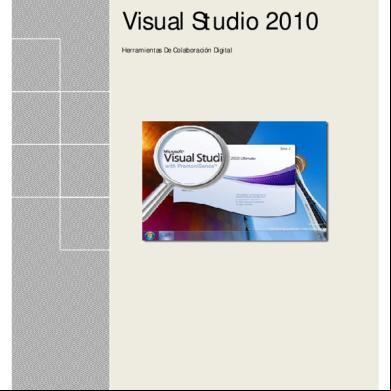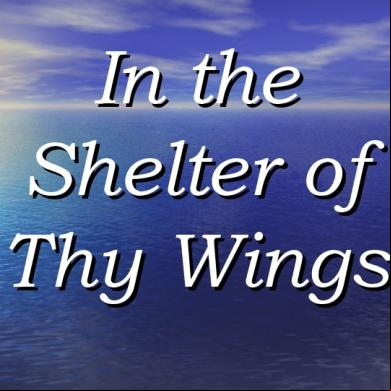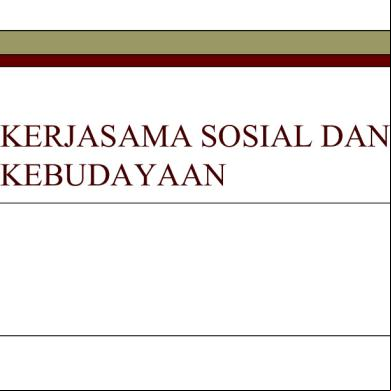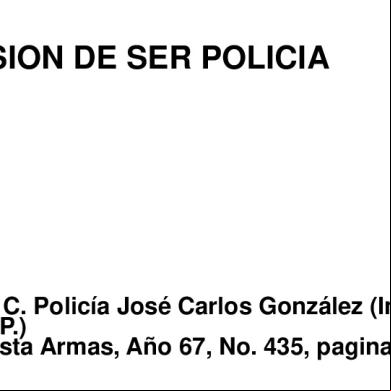Visual Studio 2010 2i2r7
This document was ed by and they confirmed that they have the permission to share it. If you are author or own the copyright of this book, please report to us by using this report form. Report 3b7i
Overview 3e4r5l
& View Visual Studio 2010 as PDF for free.
More details w3441
- Words: 815
- Pages: 22
Visual Studio 2010
Visual Studio 2010 Microsoft’s Visual Studio includes several programming languages:
Visual Basic Visual C# (C sharp) Visual C++ (cee-plus-plus) Visual F# JScript
Visual Basic (VB) is the third-generation event-driven programming language and integrated development environment (IDE) from Microsoft. VB is also considered a relatively easy to learn and use programming language, because of its graphical environment features and BASIC heritage. A programmer can put together an application using the components and controls provided with Visual Basic itself. Programs written in Visual Basic can also use the Windows API, but doing so requires external function declarations. The final release was version 6 in 1998.Microsoft's extended ended in March 2008 and the successor was Visual Basic . NET (now known simply as Visual Basic). Visual Studio 2010 is currently in Release Candidate and can be ed by the general public at no cost.
Visual Basic • VB is an object-oriented programming language. • Means you work with objects in building an application. • Examples: Form objects, Button objects, TextBox objects, Label objects, ListBox objects, PictureBox objects, and more.
Visual Basic VB is also termed an event-driven programming language because you will write program code that responds to events that are controlled by the system . Example events include: · Clicking a button or menu. · Opening or Closing a form. · Moving the mouse over the top of an object such as a text box. · Moving from one text box to another.
Object A thing – like a noun in English. Examples includeforms and controls you place on forms such as buttons, text boxes, and icons. Property Objects have properties – like adjectives in English. Properties describe object behaviors. Examples of properties include Text, Name, BackColor, Font, and Size. Refer to a property by the notationObjectName.PropertyName (use the .dot notation) – example: TotalDueTextBox.Text orLabel.ForeColor. Method Like a verb in English – these are the actions that objects exhibit. Examples include methods to Show and Hide forms and methods to Print and Closeforms. Refer to a method with the notationObjectName.MethodName – example Me.Closewill close the current form.
the Integrated Development Environment Familiarize yourself with the Integrated Development Environment (IDE). · Across the top are menus with different options used in the deg of an application. · Toolbars with shortcut icons are shown below the menus. · Form Designer (also termed the Document Window). o Displays open documents such as the Form1 shown in the figure below. o Tabs along the top are used to allow you to switch rapidly between open documents. o Every project starts with a default form named Form1 – the form you modify to build your business application. o The form can be resized by using the sizing handles. o The form can be renamed (you’ll do this later in an exercise). · Solution Explorer Window – displays filenames for files that comprise a project. The solution name is also shown here (Ch01VBUniversity). · Properties Window – displays properties of the currently selected object – in the figure the properties displayed are those of the Form object. · ToolBox Window – this is shown along the left edge of the figure in collapsed display.
The Toolbox The Toolbox: · Contains controls that are used to build forms. · Can be expanded or collapsed with the Pin/Unpin icon. · Parts of the Toolbox can be expanded/collapsed with the white and black pointer icons to the left of the groupings. · Used to add controls (tools) to a form by either double-clicking or dragging/dropping (your option on which to use).
Solution Explorer
Displays filenames for files that comprise a project.
Properties Window
Displays properties of the currently selected object – in the figure the properties displayed are those of the Form object.
TOOLBOX 1.Label Displays information that will not allow the to change its content.
Label
Prefix: lbl
lblFirst, lblFirst_Name, lblFName
TOOLBOX 2. Textbox Allows to input text/information to be used by the program.
Textbox
Prefix: txt
txtFirst, txtFirst_Name, txtFName
TOOLBOX 3. OptionButton Known as radio button.
Prefix: opt
optWindows, optLinux, optMacOs,
TOOLBOX 4. Checkbox I provide the a chance to select as many options desired
Prefix: chk
chkSport, chkReading, chkChess
TOOLBOX 5. CommandButton Performs task when the triggers an action via click event.
Prefix: cmd
cmdSave
TOOLBOX 6. Frame Group related control(s) together in an interface.
Prefix: fra
fraPizza, fraToppings, fraDrinks
TOOLBOX 6. ComboBox Combine text with a list box.
Prefix: cbo
cboWords, cboNames
TOOLBOX 7. ListBox Displays text in a box
Prefix: lst
lstNames
TOOLBOX 8. Timer I perform task(s) at programmer’s specified intervals..
Prefix: tmr
tmrTime
TOOLBOX 9. ProgressBar I have the capability to convey the progress of a task in a percent format, such as or file transfer. Prefix: prg
prgProgress
TOOLBOX 9. PictureBox A container of picture(s) to be placed on the form.
Prefix: pic
picLogo
Visual Studio 2010 Microsoft’s Visual Studio includes several programming languages:
Visual Basic Visual C# (C sharp) Visual C++ (cee-plus-plus) Visual F# JScript
Visual Basic (VB) is the third-generation event-driven programming language and integrated development environment (IDE) from Microsoft. VB is also considered a relatively easy to learn and use programming language, because of its graphical environment features and BASIC heritage. A programmer can put together an application using the components and controls provided with Visual Basic itself. Programs written in Visual Basic can also use the Windows API, but doing so requires external function declarations. The final release was version 6 in 1998.Microsoft's extended ended in March 2008 and the successor was Visual Basic . NET (now known simply as Visual Basic). Visual Studio 2010 is currently in Release Candidate and can be ed by the general public at no cost.
Visual Basic • VB is an object-oriented programming language. • Means you work with objects in building an application. • Examples: Form objects, Button objects, TextBox objects, Label objects, ListBox objects, PictureBox objects, and more.
Visual Basic VB is also termed an event-driven programming language because you will write program code that responds to events that are controlled by the system . Example events include: · Clicking a button or menu. · Opening or Closing a form. · Moving the mouse over the top of an object such as a text box. · Moving from one text box to another.
Object A thing – like a noun in English. Examples includeforms and controls you place on forms such as buttons, text boxes, and icons. Property Objects have properties – like adjectives in English. Properties describe object behaviors. Examples of properties include Text, Name, BackColor, Font, and Size. Refer to a property by the notationObjectName.PropertyName (use the .dot notation) – example: TotalDueTextBox.Text orLabel.ForeColor. Method Like a verb in English – these are the actions that objects exhibit. Examples include methods to Show and Hide forms and methods to Print and Closeforms. Refer to a method with the notationObjectName.MethodName – example Me.Closewill close the current form.
the Integrated Development Environment Familiarize yourself with the Integrated Development Environment (IDE). · Across the top are menus with different options used in the deg of an application. · Toolbars with shortcut icons are shown below the menus. · Form Designer (also termed the Document Window). o Displays open documents such as the Form1 shown in the figure below. o Tabs along the top are used to allow you to switch rapidly between open documents. o Every project starts with a default form named Form1 – the form you modify to build your business application. o The form can be resized by using the sizing handles. o The form can be renamed (you’ll do this later in an exercise). · Solution Explorer Window – displays filenames for files that comprise a project. The solution name is also shown here (Ch01VBUniversity). · Properties Window – displays properties of the currently selected object – in the figure the properties displayed are those of the Form object. · ToolBox Window – this is shown along the left edge of the figure in collapsed display.
The Toolbox The Toolbox: · Contains controls that are used to build forms. · Can be expanded or collapsed with the Pin/Unpin icon. · Parts of the Toolbox can be expanded/collapsed with the white and black pointer icons to the left of the groupings. · Used to add controls (tools) to a form by either double-clicking or dragging/dropping (your option on which to use).
Solution Explorer
Displays filenames for files that comprise a project.
Properties Window
Displays properties of the currently selected object – in the figure the properties displayed are those of the Form object.
TOOLBOX 1.Label Displays information that will not allow the to change its content.
Label
Prefix: lbl
lblFirst, lblFirst_Name, lblFName
TOOLBOX 2. Textbox Allows to input text/information to be used by the program.
Textbox
Prefix: txt
txtFirst, txtFirst_Name, txtFName
TOOLBOX 3. OptionButton Known as radio button.
Prefix: opt
optWindows, optLinux, optMacOs,
TOOLBOX 4. Checkbox I provide the a chance to select as many options desired
Prefix: chk
chkSport, chkReading, chkChess
TOOLBOX 5. CommandButton Performs task when the triggers an action via click event.
Prefix: cmd
cmdSave
TOOLBOX 6. Frame Group related control(s) together in an interface.
Prefix: fra
fraPizza, fraToppings, fraDrinks
TOOLBOX 6. ComboBox Combine text with a list box.
Prefix: cbo
cboWords, cboNames
TOOLBOX 7. ListBox Displays text in a box
Prefix: lst
lstNames
TOOLBOX 8. Timer I perform task(s) at programmer’s specified intervals..
Prefix: tmr
tmrTime
TOOLBOX 9. ProgressBar I have the capability to convey the progress of a task in a percent format, such as or file transfer. Prefix: prg
prgProgress
TOOLBOX 9. PictureBox A container of picture(s) to be placed on the form.
Prefix: pic
picLogo











